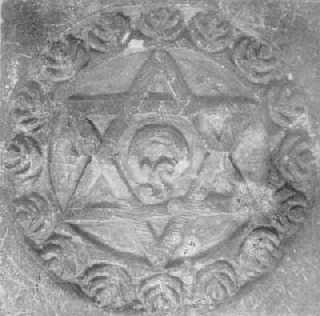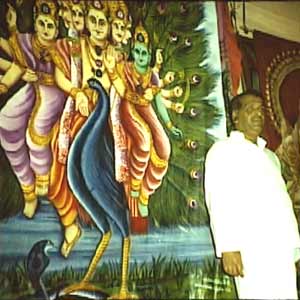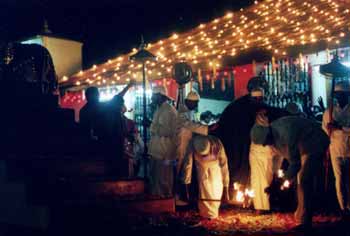
|
||||||||
|
| ||||||||
The Yantra of the Kataragama DeityPages 13-15 from "Kataragama the Holiest Place in Ceylon" by Paul Wirz, originally published in German in 1954, English translation 1966 by Doris Pralle
No sculptural representation of Skanda can be found in Kataragama, which is rather surprising, When Davy remarks, though, "Of all Gods, the Kataragama God is the most feared and such is the dread of this being that I was never able to induce a native artist to draw a picture of it," it is definitely not true and one can easily see for oneself when entering the Maha Devale in Kataragama, because there is and was always a painted representation of the deity. Furthermore, coloured pictures of the different deities are being sold in Kataragama as well as in other places, among which Skanda, too, is represented. Also bronze representations of the deity were easily to be got in Southern India, at least in earlier times. Today though they have, like bronze figures in general, become rather rare. This does not contradict the fact that in the Maha Devale at Kataragama there is actually no sculptural representation of the deity. The only symbol is the lance (vel). One of those, as we have seen, is put up in front of the Maha Devale and also at the, other temples and sanctuaries and can often be seen placed in the ground, Many pilgrims bring an iron lance with them, which they leave in Kataragama as a votive offering. The silver needles with which they allow themselves to be pierced through cheeks and tongue are likewise nothing else but small lances, which therefore, are symbols of the deity himself. To the not-so-well-to-do who cannot afford to procure one or more of these needles, the same are lent for a small fee by swamis staying on the right bank of the Menik Ganga. While formulas are recited, they are pierced at once through cheeks and tongues. In this case suggestion plays an important role.
Arriving at the Maha Devale the pilgrim or penitent really has nothing to see. The front room of the temple, which may be entered by anybody, is sober and bare. Three differently coloured curtains separate it from the room behind, the Sanctum, which can only be entered by the two highest priests, the maha-kapurala and the devini-kapurala. On the front curtain the deity is painted with the two wives and their mount, the peacock. In the most holy room, in the rear is the sanctum sanctorum, a small box or relic container which contains the precious yantra made by the Mutulinga swami. Nobody except the two highest priests has ever seen the object which (they say), is supposed to be of gold leaf. Of what kind the yantra itself is, is equally unknown. Some allege that it only represents the hexagon, formed out of two triangles placed on top of each other, the diagram of Skanda. Thus this yantra, up to a point, takes the place of a representation of the deity and is being treated and worshipped in precisely the same way, as is done in other temples with representations of deities, though with the difference that the people will not under any circumstances see the relic. Why this is so will possible never be determined. This small box containing the yantra plays, of course, the main role during the processions on the occasion of the big festivity. This precious object is the heart of everything. Every evening it is brought by the devini-kapurala who is completely covered in a long white cloth, out of the most holy room of the Maha Devale on to the back of a prepared elephant.
Soon after, the latter is led in solemn procession around the different temples up to the temple of Valli-amma about 300 metres away. Here the box with the yantra is taken inside the temple by the devini-kapurala with the same solemnity and is kept in it for about a quarter of an hour. This temple, too, contains two rooms parted from each other by two curtains; of these the one behind, the sanctum, is only to be entered by the two highest priests, since it serves as the depository for the relic on each occasion. This is repeated every evening during 10 [Editor's note: actually 14 to 15] successive nights, the last time being on the full-moon night, which forms the culmination point of the whole festivity. During this full-moon night the small box with the yantra is left until dawn in the temple of Valli-amma. This is the “Wedding night” of the deity. The taking across of the yantra to the temple of Valli Amma and the leaving of it there for a certain time is nothing other than the symbolic union of the deity with his shakti. This is also always customary in other Hindu temples. Little -- very little -- is known about the relic, and the little that is known is not even established with certainty, being either legend or perhaps oral tradition. No wonder that many still diaintain that the whole story of the yantra is only invention or sly deception by priests to make the gullible people believe in something. No human except the Maha kapurala and the devini kapurala has ever cast an eye on the ‘precious relic.’ Who can then maintain, that such exists at all? In the older reports, too, the yantra of the Kataragama deity is mentioned only incidentally. The government official of the Uva province, Mr. Baumgartner, who visited Kataragama in the year 1897 during the big festivity, reports that at the taking of an inventory at the Maha Devale no relic was found. It is possible, of course, that on this occasion the yantra had been completely overlooked, as one perhaps mainly expected to find a statue of a god in the sanctum, or otherwise the yantra had been taken away into safety in good time. Significant in any case is that Dr. Davy mentions clearly an idol, which, during his visit to Kataragama in the year 1819, was kept hidden in the jungle because of the insecurity prevailing at that time. However, this statement has to be accepted with caution, as we do not know what kind of idol he refers to. See also Paul Wirz's chapter on "Traditions and Legends of Kataragama"
|


